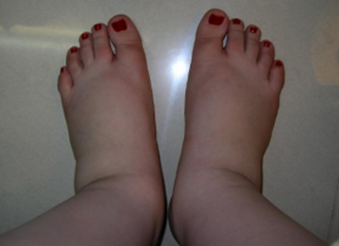Congestive Heart Failure: Clinical Case Study
Congestive Heart Failure Case |
HPI: MT, a 52-year-old woman, presents to your office, complaining of 3 days of increasing shortness of breath. Her dyspnea is worse with exercise and relieved somewhat by rest. She has had to prop herself up in bed to avoid feeling like she’s “drowning.” She also complains of swelling in both ankles (see Figure 3). She has also developed a cough productive of pinkish-coloured sputum. PMI: She denies alcohol use and gave up smoking after her heart attack last year. Prior to that, she had smoked a pack-per-day for over 30 years. She denies having a significant cough. She is on a “water pill” but does not always take it. She takes a “baby aspirin” daily. P/E: MT is an obese female in moderate respiratory distress. Vitals: HR 112; RR 24; BP 150/90; Temp 37°C 98.6°; SpO2 7% on room air. Head and neck exam reveals an elevated JVP and thready coronary artery pulses. Her apex beat is enlarged and displaced downward and laterally. A fourth heart sound is present and crackles are heard in her lung bases bilaterally. Her liver edge is palpable 10 cm below the costal margin. Her peripheral pulses are weak, and capillary refill is delayed. |

Figure 1 |
| Question | Your Answer |
What is the most likely diagnosis? |
Congestive heart failure |
What in her history likely led to her current condition? |
Her heart attack last year likely led to damage that decreased the effective cardiac output by damaging the ventricular heart muscle. |
Why is she having difficulty breathing? |
Decreased cardiac output led to a backup of the blood into her lungs (left heart failure), increasing hydrostatic pressure in her lung vessels. This caused fluid to leak out of the vessels into the surrounding interstitial space, capillaries, and alveoli. This hampers oxygen exchange (dyspnea) and the crackles heard on auscultation. |
Why are her ankles swelling? |
Decreased cardiac output led to a backup of the blood into her peripheral vessels (right heart failure), as evidenced by the elevation of her jugular venous pressure (JVP). Increased blood in her peripheral vessels increases the hydrostatic venous pressure leading to fluid leaking into the interstitial tissues |
Why might you choose digoxin to treat this patient? |
Digoxin helps to slow the heart rate (through slowing conduction, especially through the AV node), thus decreasing cardiac work, and increases cardiac contractility, thus increasing stroke volume and cardiac output |
How might angiotensin-converting enzyme inhibitor (ACE-I) drugs help this patient |
Decreased formation of angiotensin II, a powerful vasoconstrictor, decreases peripheral resistance (afterload). Decreased aldosterone, a hormone that leads to conservation of salt and water, leads to increased urine formation and a decrease in blood volume (decreased preload). Both of these effects decrease the work of the heart and reduce the hydrostatic intravascular hydrostatic pressure. |